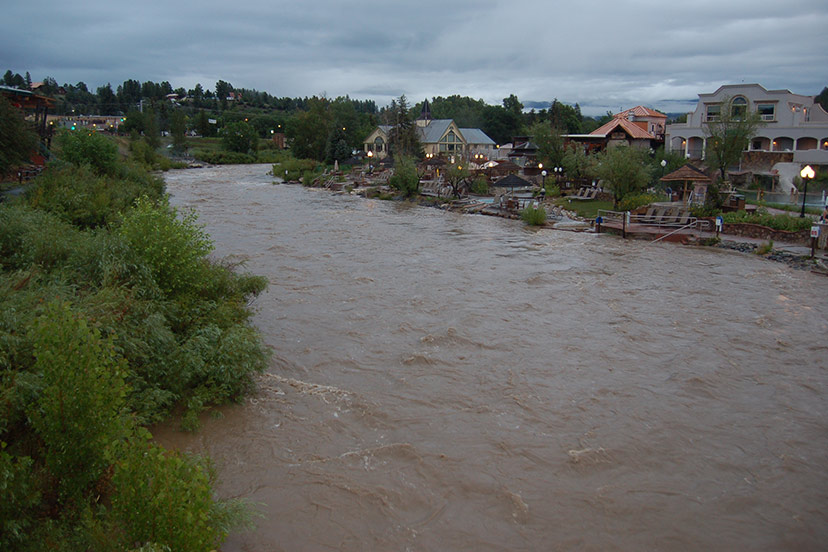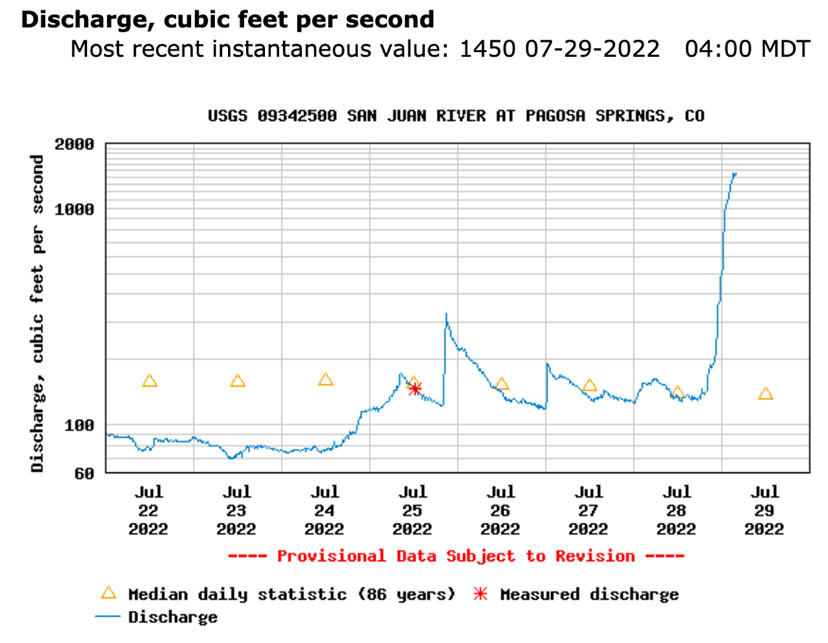PHOTO: The San Juan River, July 29, 6:30am.
I’ve been visiting a U.S. Geological Survey web page lately, while researching my recent eight-part article about the San Juan Water Conservancy (SJWCD).
Earlier this week, SJWCD received a report on current water demand in Archuleta County, and possible future water demand, looking at 2050 water needs. The report was written by Wilson Water Group. In my editorial series, I shared some of my concerns about the focus of the report (specifically, comments about the need for a Dry Gulch Reservoir, and the lack of discussion about agricultural water use) and about the inaccuracy of some of the data used.
The USGS website shared this chart displaying the level of the San Juan River in downtown Pagosa Springs, as of July 29. This morning, at 4am.
According to this chart, the San Juan was flowing this morning at 1,450 CFS (cubic feet per second).
For most of July, the flows had been less than 100 CFS.
In the chart above, you can see little yellow triangles that indicate the ‘average’ discharge flowing through downtown Pagosa, averaged over the past 86 years. The discharge for most of July had been considerably lower than the ‘average’.
The flows this morning, however, have approached the record flow for this date in July.
The maximum measured discharge for July 29 was 1,660 CFS. The USGS made that measurement in 1957.
With rain in the forecast for this weekend, I suppose it’s possible the San Juan River could set a new record?
To put 1,450 CFS into perspective, the Pagosa Area Water and Sanitation District (PAWSD) sold a total of about 1,350 acre feet of treated water during 2021. If 1,350 acre feet per year were translated into cubic feet per second, it would equal a little less than 2 CFS.
The mainstream media has been well-populated, this year, with stories about the disastrously low water levels in Lake Powell and Lake Mead, the two largest reservoirs in the U.S. The San Juan River helps feed those two reservoirs, when it meets the mighty Colorado River near Page, Arizona. But even a near-record flow of the San Juan through Pagosa Springs on July 29 is a mere drop in the bucket for reservoirs that are drained by California, Arizona and Nevada, faster than they can be filled.
The U.S. Bureau of Reclamation (USBR) is scrambling to keep Powell and Mead from dropping even lower this summer, and plans to release water stored in three large upstream reservoirs: Flaming Gorge in Wyoming/Utah, Blue Mesa in Colorado, and Navajo Reservoir, which begins here in Archuleta County and extends for about 25 miles into New Mexico.
It looks like Navajo Reservoir is currently about 57% full, which calculates to about 970,000 acre feet of stored water.
USBR plans to drain a total of about 181,000 acre feet of water out of the three upstream reservoirs, including about 20,000 acre feet from Navajo.
At last night’s meeting (July 28) of the PAWSD board of directors, the four directors in attendance — Jim Smith, Glenn Walsh, Drew Mackey, and Bill Hudson (myself) — considered a couple of requests from the Village Care Partnership LLC.
The partnership has been working on plans for an 80-acre mixed-use development, labeled ‘Pagosa Views’, to be built — potentially — on a tract of vacant land immediately west of the Pagosa Springs Elementary School.
The two requests were presented by one of the project partners, Phil Williams, and by local realtor Shane Jones.
1. A ‘Will Serve’ letter from PAWSD that can be shared with potential lenders, for project financing.
2. Inclusion of 75 acres that are not currently within the PAWSD District (and thus, have not been paying taxes into the PAWSD district.) About 5 acres are already within the district.
Disclosure: I currently serve on the Pagosa Area Water and Sanitation District (PAWSD) board of directors, but this editorial reflects only my own personal opinions, and not necessarily those the PAWSD board as a whole.
The ‘Will Serve’ letter is a curious animal. Apparently, the lenders who might help finance the ‘Pagosa Views’ project want to have some kind of assurance that the hundreds of planned homes and businesses will actually have access to water and sewer services.
Last month, the Town of Pagosa Springs issued a ‘Will Serve’ letter to the partnership, indicating that — if the partnership jumps through all the required legal and regulatory hoops — the Town’s sewer district, Pagosa Springs Sanitation General Improvement District (PSSGID), will pump the subdivision sewage seven miles uphill to the PAWSD Vista Waste Water Treatment Plant.
You can read about that approval process here.
If issued, the PAWSD ‘Will Serve’ letter, meanwhile, would refer specifically to the District’s willingness to supply drinking water.
But we will note that, on the sewage side, PSSGID would merely pump the sewage uphill to the PAWSD plant. (No small task, when we note the rate at which the Town’s sewer pumps have been failing.) Most of the drinking water supplied by PAWSD would ultimately become waste water — from sinks, showers, washing machines, toilets — and would return to the Vista plant, to be treated.
So the thought of supplying drinking water to a large, new subdivision also requires some thought about treating the resultant waste water.
When the PAWSD board discussed the idea of a ‘Will Serve’ letter last night, the board and staff agreed that the Town Council’s ‘Will Serve’ letter might serve as a fine model for a future PAWSD letter, considering that the Town’s letter essentially promises nothing at all — except that it will someday consider whether to serve the new subdivision.
The PAWSD board seemed comfortable with the same approach. Make a promise to someday consider including ‘Pagosa Views’ into the water district, if all the ducks get lined up properly.
But of course, sewage treatment is not the only question.
Does PAWSD even have enough water resources to serve a new subdivision of this size? Maybe 675 residential units, plus some number of lodging and commercial buildings?




